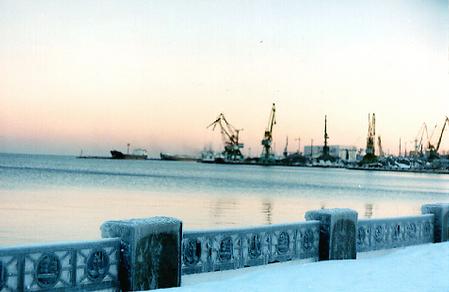 The Republic of Karelia is located in the north-western part of Russian Federation, taking intervening position between the basins of Barents and Baltic seas. The total territory of Karelia is 172 400 sq.km. with a population of 800 000 people. The capital of the Republic is the city of Petrozavodsk situated on the shore of Onego lake (280 000 inhabitants). The Republic of Karelia is located in the north-western part of Russian Federation, taking intervening position between the basins of Barents and Baltic seas. The total territory of Karelia is 172 400 sq.km. with a population of 800 000 people. The capital of the Republic is the city of Petrozavodsk situated on the shore of Onego lake (280 000 inhabitants).
In the northeast, the Republic is washed by the White Sea with a shore line of 630 km.; in the west Karelia borders on Finland(border line length approx. 700 km.); in the north, on Arkhangelsk Region; in the south, on Vologda and Leningrad Regions of the Russian Federation.
The most part of the republic's territory (148 000 sq.km. or 85%) is comprised ofstate forest stock.
The total growing stock of timber resources in the forests of all categories and ages is 807 million cubo metres.
The mature and overmature tree stock amounts to 411,8 million cubo metres, of which 375,2 million cubo metres is coniferous.
Agricultural holdings constitute 217,6 thousand hect., of which 85,4 thousand hect. are arable lands, 85,9 thousand hect. are meadows and 41,2 thousand hect. are pastures.
There are 27 000 rivers and over 60 000 lakes in Karelia. Lake Ladoga and Lake Onego are the largest lakes in Europe. Lakes and swamps contain about 2 000 cubo kilometres of high-quality fresh water.
50 useful minerals are found in Karelia, located in more than 400 deposits and orebearing layers.
Among them are:
iron ores (Kostomuksha District);
chrome and titanium-magnetite ores (Pudozh District);
vanadium (Medvezhjegorsk District);
molibdenum (Belomorsk District);
gold (Kostomuksha, Kondopoga, Suojarvi Districts);
quartzites (Muezersky District), including crimson quartzites(Prionezhsky District);
shungites (Medvezhjegorsk District);
gabbro-diabases (Prionezhsky District);
granites (Loukhi, Pitkjaranta, Pudozh District);
marble (Pryazha, Sortavala Districts).
Karelia has been identifies as having diamond deposits. At the present time a search is being carried out.
Virgin woods, clean lakes and rivers, historical and cultural monuments attract hundreds of thousand of travellers to Karelia today and the flow of tourists will increase.
The Republic has a rather well developed network of transport infrastructure. Water communications connect Karelia with the Barents, Baltic, Black and Caspian Seas (through the system of rivers, lakes and canals).
Federal railway and automobile highways cross Karelia and connect Murmansk Region and Murmansk sea port with St.-Petersburg, Moscow, the center of Russia and with Finland.
Regular airline service connects Petrozavodsk with Joensuu and Helsinki in Finland.
Almost all the territory of Karelia is included in the European systems of honeycomb mobile network NMT-450 and GSM.
In accordance with the Constitution of Russia, the Republic of Karelia is a subject of the Russian Federation.
The Republic has its own constitution, legislative body (Parliament) and Government, headed by the Chairman-main executor of power and highest officer in the Republic.
The Republic has its own administrative-territorial division, made up of 18 regions and towns. Local self-government is carried out within the bounds of administrative-territorial units. It is separate and independent of the system of state (republican) government in accordance with Russian and Karelian legislation.
The main feature that determines the historical and cultural peculiarity of K arelia is its border position. The cultural originality of Karelia began forming before the appearance of clearly defined borders and before the crystallization of the features that distinguish the Russian and the European civilizations. Karelia, as a culturally original region of Northern Europe, appeared as a result of the interaction of the Baltic-Finnish and the Eastern Slavic cultures in the North. It was on the territory of the Karelian ethnocultural border that the top examples of the art of the peoples of different origins were preserved and recorded in the 19th century, such as the epic Karelian-Finnish runes which were compiled in the famous "Kalevala" and the Russian epic songs. The dialogue and the synthesis of traditions is the basis of the cultural originality of the region and characterizes all the stages of its history. arelia is its border position. The cultural originality of Karelia began forming before the appearance of clearly defined borders and before the crystallization of the features that distinguish the Russian and the European civilizations. Karelia, as a culturally original region of Northern Europe, appeared as a result of the interaction of the Baltic-Finnish and the Eastern Slavic cultures in the North. It was on the territory of the Karelian ethnocultural border that the top examples of the art of the peoples of different origins were preserved and recorded in the 19th century, such as the epic Karelian-Finnish runes which were compiled in the famous "Kalevala" and the Russian epic songs. The dialogue and the synthesis of traditions is the basis of the cultural originality of the region and characterizes all the stages of its history.
Starting from the Middle Ages, Karelia was a territory on the border of the Swedish Kingdom and the Novgorod Republic, and later the Moscow Kingdom.
|













 State
State  Regions
Regions